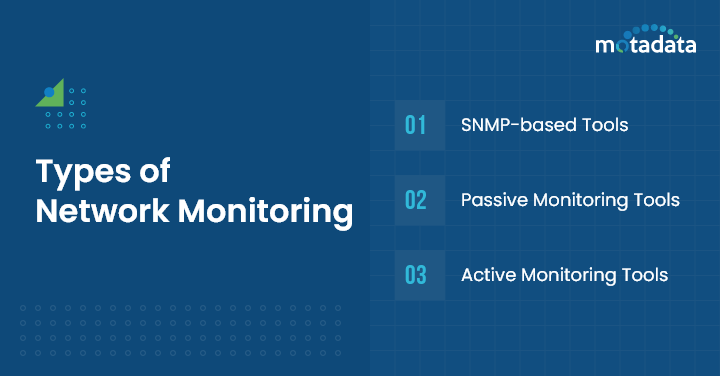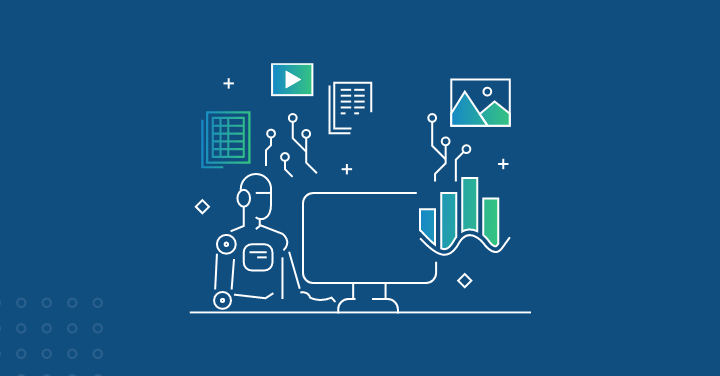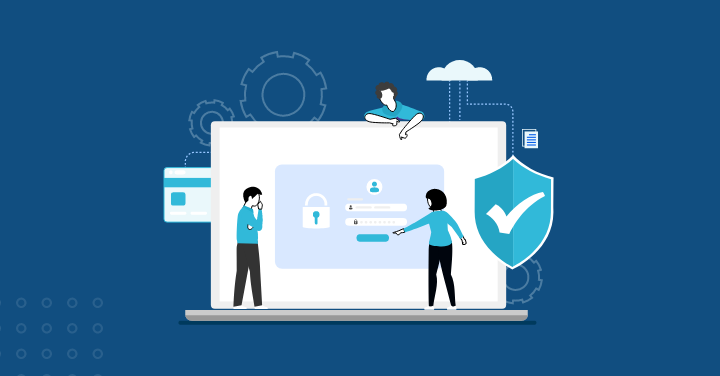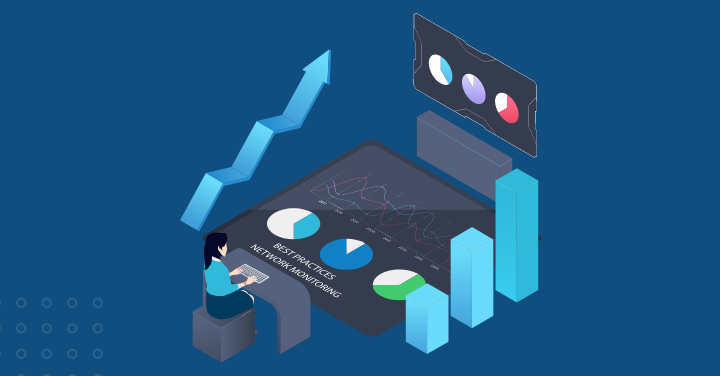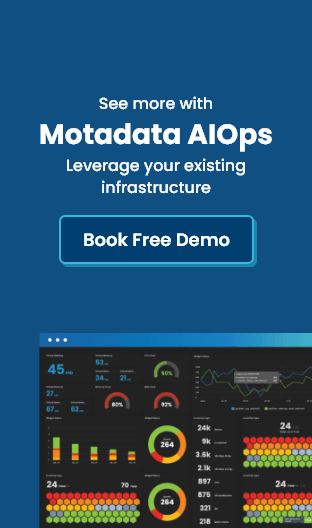In today’s fast-paced digital world, the importance of network monitoring is growing by leaps and bounds. With real-time network monitoring, businesses can transform their user experiences and drive unstoppable growth. Whether you run a small business or a large corporation, incorporating network monitoring tools can help in the smooth functioning of your networks.
Join us as we unveil the top benefits of network monitoring in the modern business landscape. Further, we will discuss its types and common network issues that can disrupt your performance. Stay with us to learn more about network monitoring tools and unlock their real power.
What is Network Monitoring?
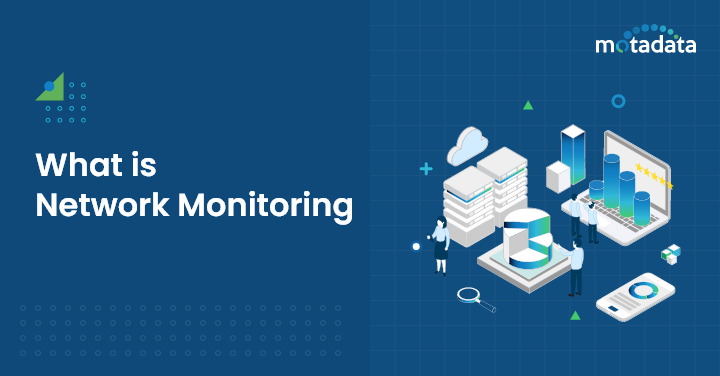
Network monitoring is a constant practice that most network administrators perform to identify connection failures and other network issues. With proper analysis, Network and System Administrators can deliver better network quality. The monitoring process involves:
- Stats collection
- Analyzing trends in network traffic
- Optimization of network settings
- Detection of issues and threats in real time
Role of AI and automation in modern network monitoring
Fast changes are happening in the role of AI and robotics in keeping an eye on networks. This change affects how we run and protect networks. These technologies do more than just track and send messages. They add tools for automatic fixes and research that can predict what will happen.
Network tracking tools that are run by AI can look at a lot of data from different sources. They look for patterns, find problems, and guess what will happen before it does. If you manage networks in this smart way, you can keep them running smoothly and avoid costly downtime.
Automation makes running a network easier by taking care of things like finding devices, managing configurations, and quickly solving problems. This lets the IT teams work on bigger projects while keeping the network safe and running smoothly.
The Role of Network Monitoring in Business Operations
Network monitoring is essential for modern business operations. It affects how well a business works, how happy customers are, and how smoothly it runs. As companies use more technology, the network is vital for key processes, which means its stability and performance are crucial.
Good network monitoring helps data flow smoothly, supports important applications, and keeps operations secure and compliant. By finding and fixing network issues early, businesses can lower downtime, boost productivity, and provide a better customer experience.
Impact of network failures on business continuity
Network problems can make it hard for a business to run. They could stop the business from running, cost it money, and hurt its image. In today’s connected world, even a short loss can lead to bigger problems. This can make customer service worse, mess up supply lines, and make workers less productive.
Businesses that count on e-commerce or online transactions can lose a lot of money when their systems are down. Profits can be hurt by lost sales, missed opportunities, and recovering costs.
Not only do network problems cost money right away, but they can also hurt customer trust and the brand’s reputation. In today’s market, it’s important to keep your brand’s image in good shape. Any problem with the service can cause customers to leave and damage the brand’s image for a long time.
Real-time detection of network device failures and performance issues
Network problems can make it hard for a business to run. They could stop the business from running, cost it money, and hurt its image. In today’s connected world, even a short loss can lead to bigger problems. This can make customer service worse, mess up supply lines, and make workers less productive.
Businesses that count on e-commerce or online transactions can lose a lot of money when their systems are down. Profits can be hurt by lost sales, missed opportunities, and recovering costs.
Not only do network problems cost money right away, but they can also hurt customer trust and the brand’s reputation. In today’s market, it’s important to keep your brand’s image in good shape. Any problem with the service can cause customers to leave and damage the brand’s image for a long time.
How AI-driven anomaly detection helps prevent unexpected downtime
AI-driven anomaly detection is changing network monitoring. It helps find possible issues before they cause unexpected downtime. Traditional monitoring systems use set limits and rules. However, these may not capture the small details of current network behavior.
AI looks at large amounts of past network performance data. This helps it create a normal activity baseline. With this, it can spot small changes or problems that could mean an issue, even if they don’t break any specific limits.
AI-driven anomaly detection notices patterns and links that people might overlook, giving early alerts about potential failures. This helps IT teams check and solve problems early, often before users or essential business processes are affected.
Why Network Monitoring is Important for Enterprises and Small Businesses?
An enterprise uses different network components to perform day-to-day operations. Faults in the network can frustrate a user, but at the same time, they can increase expenses for your business. The best solution in that case is to add a network monitoring solution to your list. This decision will help you gain valuable insights and troubleshoot network issues faster.
Here are a few more reasons to convince you how network monitoring solutions can benefit your enterprise:
Prevents Network Outages from Happening in the First Place
One of the biggest nightmares of an IT manager or network administrator is a network outage. However, with an appropriate monitoring solution, you can put a halt to these outages before they start. The monitoring tool will look for any suspicious performance behavior and notify you of the issue before it affects your overall performance.
Discover Security Threats
Apart from tracking the health and performance of networks, networking monitoring tools even help in dealing with security threats. On detecting any abnormal data transfers or malware within your system, it instantly sends an alert. A few monitoring solutions include network detection and response (NDR) features that aid in detecting harmful actors on a network and removing them.
Reduce Performance Failure Time
At times even after discovering the issue, fixing it can take a long time. However, with monitoring tools, the team immediately receives a notification and proper actions take place to reduce the mean time to repair (MTTR) of network performance issues.
Enhancing cybersecurity with Zero Trust and AI threat detection
With cyber threats getting worse all the time, network tracking is a must for making things safer. Business can find and stop bad behavior right away by using Zero Trust ideas and AI-powered tools to find threats.
When you have zero trust, you don’t instantly trust any user or device on the network. Instead, rights and access are checked all the time. When network tracking tools are used with Zero Trust systems, they make it easy to see what is happening on the network. This helps find efforts to get in without permission, data leaks, and other bad things that happen.
Even more network security is gained by AI tools that look for threats. They look at the data on the network for odd patterns and signs that could point to malware, phishing, or other threats. Cyberattacks are less damaging when you see and act on threats quickly. This also keeps private data safe from people who shouldn’t have access to it.
Supporting multi-cloud and hybrid cloud monitoring
Businesses that use multi-cloud and hybrid cloud plans need to change the tools they use to keep an eye on their networks. They should let you see and control everything in all of your environments. To keep things running smoothly, safely, and legally in a multi-cloud environment, you need to use key parts of a unified monitoring method.
These days, network monitoring tools can now connect to big cloud service providers. They make it easier to keep track of cloud resources, see how well an app is running, and see events that happen during application performance tracking. No matter where their apps and data are, this makes it easy for businesses to keep an eye on their whole network infrastructure from one place.
By connecting data from on-premises and cloud setups, businesses can get a full picture of how their networks are running. They can find problems before they happen, make better use of resources, save money, and work more efficiently. Businesses that want to get the most out of cloud computing while still keeping control and visibility over their data and apps need cloud-aware network monitoring tools. These tools should include full network monitoring for better performance assessment.
Monitoring IoT devices and edge computing environments
Network monitoring faces new issues as a result of the proliferation of Internet of Things devices and edge computing. Because of the enormous number of connected devices and the fact that data processing is taking place closer to the location where the data is created, new methods of monitoring everything are required. In this way, both performance and security are maintained at their highest possible levels.
It is typically difficult for standard network monitoring solutions to manage the many different types and sizes of Internet of Things devices. Every single gadget transmits information in a unique manner and possesses a unique set of vulnerabilities. Due to the fact that the data is processed at the location where it is created, tracking data processing at the edge requires the use of specialized tools and ways of doing things.
Solutions for network monitoring that are aware of the edge can locate and monitor Internet of Things devices. When it comes to secure communication channels, they are also able to check the data flows that occur between edge devices and the cloud. This monitoring takes on a crucial role. It contributes to the maintenance of Internet of Things systems that are robust, quick, and secure. With this approach, organizations are able to fully profit from the tremendous possibilities offered by these new technologies.
Optimizing network resources for sustainability and cost savings
To get the most out of network tools, you need to keep an eye on them. Save a lot of money and help make projects more eco-friendly. Businesses can find ways to improve and make better use of their resources by looking at how devices work, how much bandwidth is used, and the trends of network traffic.
It helps businesses figure out what uses too much energy by keeping an eye on how much energy network devices like switches and routers use. Then they can take steps to save energy. Using real-time temperature and humidity data to improve data center cooling systems is another way to make IT infrastructure more environmentally friendly.
By using broadband well, companies can cut costs. They can cut down on data transfers that aren’t needed and find resources that aren’t being used well, which can help find speed problems. They can make their IT infrastructure work for them by knowing how they normally use their network. This keeps them from having to spend too much on extra features or capability.
Types of Network Monitoring and Their Uses
There are three types of network monitoring tools, and each comes with their functions, benefits, and limitations.
1. SNMP-based Tools
SNMP-based Network Monitoring tools keep track of network devices using the SNMP protocol. It has an SNMP agent that helps network admins to constantly manage and track the status of each network device and its resource consumption. As and when a network node experiences resource overload or becomes unavailable, SNMP tools send an instant alert. Regardless of the hardware or software type, SNMP enables communication between numerous network devices.
A few SNMP commands used by the tool are:
- Snmpget
- Snmpwalk
- Snmpset
- snmptrap
2. Passive Monitoring Tools
To keep an eye on the real user data, i.e., the traffic flow, we recommend using a passive network monitoring tool. The tool creates aggregate traffic statistics and segments them into different sections depending on hosts and protocols. Thus, making it easier for network and system administrators to discover machines responsible for using up a particular network capacity. You can also run scans on a particular series of packets to identify the issue between a client and a server.
3. Active Monitoring Tools
Real packets are introduced into the network using Active Monitoring Tools that assist in bandwidth monitoring, measuring end end-to-end reachability, and tracking link usage, and& other network properties. It can be further used to run tests from the user’s point of view by carrying out actual transactions and analyzing performance. Using the active monitoring tool, users can identify and report feedback and concerns regarding performance deterioration faster and more accurately.
What Information is Analyzed by Network Monitoring?
During a network discovery process, several devices and applications contribute to the massive amounts of data that network monitoring systems analyze. This information is useful for understanding user actions, security events, device health, and network traffic trends.
By examining this data, companies can learn about their network’s performance, security, and areas for improvement.
Network traffic & data transfer analysis
Important components of network monitoring include data analysis, data transfer monitoring, and monitoring of network traffic. Their presence sheds light on the data flow inside the network. In order to ensure that programs function properly, this study can detect potential slowdowns. Communication trends, bandwidth use, and potential delays are revealed by monitoring tools through the capture and examination of network packets.
Improving bandwidth consumption requires knowledge of network traffic patterns. We are able to maintain a smooth user experience and concentrate on important applications thanks to it. For example, we might have to change the way traffic flows or establish quality of service (QoS) rules to make sure critical data gets priority if some apps are using up all the bandwidth.
We can spot suspicious network activity that can indicate security issues by analyzing data transfer patterns. Any suspect activity, such as an uptick in outgoing traffic, connections from unknown or questionable IP addresses, or data transfers at inconvenient times, should be taken seriously.
Cloud infrastructure monitoring
Companies that rely on cloud services must have cloud infrastructure monitoring in place. As a result, data and apps stored in the cloud are more likely to remain accessible, secure, and operating efficiently. Businesses can observe the efficiency and use of resources by keeping tabs on things like storage, databases, and virtual machines.
Cloud services such as Amazon Web Services (AWS), Microsoft Azure, and Google Cloud are integrated into modern monitoring systems. These instruments gather data from cloud services in the form of performance indicators, logs, and security incidents. Next, the data is examined for issues, ways to better employ resources, and compliance with security regulations.
Preventing performance issues, keeping applications running, and controlling expenses in a changing cloud setting requires good monitoring of the cloud infrastructure. To make the most of cloud computing without giving up control of critical assets, organizations should routinely monitor cloud resources.
AI-driven compliance and security reporting
The report-writing process is made easier with AI-powered security and compliance reporting. Insights gained from these studies might help shed light on industry standards and best practices. Due of the many benefits they offer over more conventional manual reporting techniques, they are essential for top-notch security.
Without any help from humans, machine learning algorithms can take in and analyse vast amounts of data. By doing so, we guarantee that the reports will have all the relevant information. Not only does it lessen the possibility of mistakes, but it also ensures that the reports are accurate and thorough, which is essential for meeting compliance laws.
With the use of AI reports, IT security professionals may save both time and effort. This frees them up to deal with more critical issues, like evaluating risks and handling incidents. Compliance is made easier, security operations are made more efficient, and administrative responsibilities are streamlined using this strategy.
Key Benefits of Network Monitoring
One cannot ignore the importance of network monitoring in today’s time as it brings a plethora of benefits to an organization. Network Monitoring can help address issues proactively, improve your security, and aid in efficient resource utilization.
Let us discuss a few more key benefits of network monitoring solutions.
1. Proactive Issue Detection
One of the major benefits of using network monitoring tools is, you can discover problems and their root cause quickly in a network. Quick identification will result in quick remediation of network problems. Users can quickly identify performance changes that can be problematic in future with constant monitoring of the networks.
2. Improved Network Performance
Businesses expand over the period and new devices are added to a network as per the requirement. To keep up the performance, increasing bandwidth is essential. Implementing Network Performance Optimization strategies ensures efficient network operation amid expansion. With network monitoring, you can keep a watch on all these changes and new devices. Network monitoring is a tool you may use to boost network performance and ultimately outperform your competition.
3. Enhanced Security
Attackers always look for opportunities to make a way into the network and steal data. But, you can put a halt to the attacker’s attempt by using a network monitoring tool. These tools spot anomalies and send alerts to admins before they cause any negative impact. It even identifies and reports about unfamiliar devices in the network. Overall, it enhances your security system and delivers protection from attackers.
4. Resource Optimization
Manually checking resource usage across the network can be quite challenging, especially if you have a complex network system. However, with the help of the monitoring tool, the task of identifying underutilized or overutilized resources becomes simple. With the key insights on resource consumption, admins can allocate resources more efficiently.
5. Cost Savings
Another benefit of relying on monitoring tools is, it helps in cutting your network expenses. Removing unused hardware, optimizing network traffic, and implementing trending network monitoring technologies will assist in managing costs. Businesses can save money on emergency costs by fixing problems before they arise.
6. Compliance and Reporting
For businesses, it is essential to adhere to relevant regulatory compliance. For example, if you run a hospital, you must adhere to HIPAA compliance. Similarly, other compliance standards for different industries and businesses must be met, i.e., PCI DSS, GDPR, etc. Businesses with complex networks find it challenging to adhere to security compliance. However, you can make it happen and meet SLA requirements with the use of a network monitoring solution.
7. User Satisfaction
Keeping proper track of networks and their performance, businesses can eventually improve the user experience. With proper monitoring, businesses can make sure that all employees and clients are availing uninterrupted access to the resources.
8. Troubleshooting Efficiency
The tools help enhance the effectiveness of troubleshooting by giving real-time insights into how the network is performing and identifying the underlying cause of an issue. It further helps businesses in better decision-making and boosting productivity.
Common Network Issues and Their Impact on Business Operations
Here are some of the common network issues that can be found in an organization:
Slow Internet
Even though there are several broadband packages available online, the problem of slow network connection exists. It can happen due to various factors, such as the downloading of large files, installation of new applications, and increase in employee count using the same network. Slow network connections can freeze your systems and halt your business operations.
WiFi Blackspots
Locations where you have unstable connections or weak WiFi signals are known as WiFi Blackspots. These generally occur when a router is installed at a distant location from a device. At times, it can be really frustrating for the employees as they are unable to perform daily tasks due to interference or instability.
Bandwidth Usage
Another common issue that results in poor business operations is restricted bandwidth availability. It is good to know that more devices can connect to a network with a high bandwidth. But in offices, employees constantly use the network to perform daily operations, as a result, if more and more data is downloaded, chances are high that the faster your bandwidth will reach its limit.
Cloud service disruptions & hybrid network failures
As companies use more cloud services, issues with these services and network failures can really make it hard for them to do their work. Access to important apps and data can be cut off when cloud providers go down or have performance problems. This can stop business operations.
Hybrid networks can make things more difficult because they use both on-premises tools and cloud services. If either part fails or the connection between them breaks, it can lead to connectivity issues, service downtime, and data loss. To keep these hybrid environments going well, businesses need a good plan for keeping an eye on their networks.
It is very important for companies to keep an eye on cloud services and hybrid network setups. Businesses can lessen the effects of cloud service problems and keep access to important functions steady by using backups, emergency recovery plans, and real-time monitoring tools.
Security vulnerabilities from outdated monitoring solutions
Businesses are more likely to be attacked online or have their data stolen if they use old network tracking tools. It is important to keep network tracking tools up to date because cyber threats are getting smarter. Updating your software often can help fix new security problems.
The newest security measures might not work with old solutions. This can let people into the network without permission and allow man-in-the-middle attacks. Attackers may also be able to get into the network through known flaws in older software versions.
It’s just as important to keep operating systems, firewalls, and other security software up to date as it is to keep network tracking tools up to date. A lot of the time, security patches fix bugs that were just found. This helps keep the network safe by making sure that the tracking tool doesn’t become a weak spot for attackers.
Factors to Consider When Selecting a Network Monitoring Tool
1. Ease of Implementation
No matter how helpful a network monitoring tool is, it won’t accomplish the desired goal if it’s difficult to deploy. When looking for a network monitoring tool, make sure to check if it is easy to implement and customize. Can your team deploy agents and manage different components constantly without any hassle.
2. Security
A network monitoring solution must have the ability to perform regular checks and identify tampered files. Further, it must guarantee the validity of external files that are derived from external sources and product files that are linked to the tool.
3. Scalability
Most businesses expand their network with the rise in the business. In that case, having network monitors that can scale to different network infrastructures is the best solution for effective network monitoring.
How Can Motadata Help in Your Business?
Motadata is a popular software company that provides comprehensive network monitoring solutions to businesses. Using these solutions, businesses can keep better track of their network components and resolve issues proactively.
The tool comes with various monitoring and alert features that assist enterprises in viewing and fixing network and infrastructure issues before they affect business operations. Gain access to the centralized management dashboard and its exclusive features:
- Real-time Monitoring
- Dependency Map
- Auto-Discovery
- Rich Insights
- Log analytics with context
- VPN Monitoring
- Custom Alerts
Apart from optimizing network performance, it will help businesses understand usage patterns and make informed decisions. Another important issue that Motadata covers in its plan is a security enhancement. It keeps a constant eye out for security threats and irregularities, sending out early warnings in the event of suspected breaches or vulnerabilities. This proactive strategy supports regulatory compliance by helping to protect sensitive data and sustain the reliability of IT systems.
Looking forward to enjoying the benefits of Motadata for your business? It’s time to make a move now. Sign up for a free trial and change the way you handle your IT infrastructure. Get more visibility across your network, instant updates on a loss of availability, and cost-effective solutions with a single click. Don’t wait — choose Motadata for the top-notch IT infrastructure performance that your company deserves.
FAQs
Financial Loss and reputation damage are the two main consequences that a business can face due to network outage or failure. Customers may choose to stop using a service if the problem continues to repeat or takes a long time to get fixed. Companies, as a result, can also experience reputation damage that has a long-term negative influence on brand profitability.
Network monitoring tools allow admins to keep proper track of all devices and software. It ensures that each software is up-to-date that plays a vital role in network security. With strong security measures, businesses can protect their network and its components from ransomware and malicious threats. Also, these practices help reduce the risk of downtime that most businesses usually face with networks.
You can even find possible network flaws with its investment that will further allow you to anticipate any issues and take swift action to address them. Separating your systems will also assist you to ringfence your workflows and any problems that may arise.
A network monitor solution can help identify and address several security threats and network issues that might not be visible through naked eyes. Further, it can assist businesses in reducing downtime and resolving issues responsible for interruptions. Additionally, it keeps track of outdated software, threats, and issues that need immediate attention.
Another key benefit to network monitoring is, it helps enhance network efficiency, guarantees effective employee productivity, and prompt service delivery to clients. You can even keep track of your resources and their consumption with this vital tool and gain real-time insights into the health of your network.
A few threats in complex applications go undetected and cause financial and reputational damage. So, here’s a sneak peek into top network monitoring trends that you must be aware of, including:
- Increase of Observability and Monitoring Role in Cybersecurity
- More Focus on user experience
- Expanding the Use of Automation in Deployments
- Rely more on network monitoring technologies
- Operational resilience will become the focal point in businesses
Here are a few techniques through which you can better secure your network infrastructure, such as:
- Break down networks into different segments depending on their roles and functionalities.
- Segment sensitive data and security needs across network segments
- Secure configurations in all network layers and segments
- Keep users separate from the broadcast domains using private VLANs
- Restrict less necessary lateral communications



